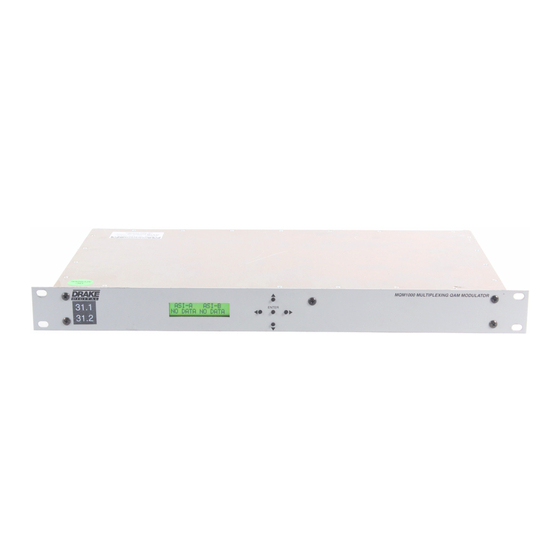DRAKE DQT861 Gebruiksaanwijzing - Pagina 11
Blader online of download pdf Gebruiksaanwijzing voor {categorie_naam} DRAKE DQT861. DRAKE DQT861 15 pagina's. Digital to qam transcoder; multiplexing qam modulator

The third option is the BASIC MGT, VCT choice. When this
selection is made, the DQT1000 or MQM1000 will build its
own MGT and VCT tables from the incoming streams even
if one or both of the streams do not contain these tables.
This solution should satisfy all types of set top boxes but
will not provide any EIT table program guide information.
The STT and RRT tables from the source are passed
through unchanged in the ENABLED mode and filtered out
in the other modes.
VCT TABLE: This menu is only available when ENABLED
or BASIC MGT, VCT has been selected in the previous
PSIP menu. You may select the TVCT - TV channel table or
CVCT table for CATV. Usually the TVCT choice must be
selected for ATSC input signals.
MAJOR CHANNEL: This menu is not available if PSIP is
disabled. When ORIGINAL is selected, the major channel
number indicated in the output tables will be that sent by
the original broadcaster. If OUTPUT CHANNEL is selected,
the major channel number will be set to the channel
number of the DQT1000 RF output channel. This setting
will determine how a channel number is displayed on a
consumer TV if the TV is tuning the output of the DQT1000
without a cable box. When a cable box is used, it usually
does not require or use this information.
QAM MODE: This menu allows the user to set the modula-
tion type for the output. Choices range from 16-QAM
through 256-QAM. A suffixes indicate DVB compliant FEC
and the B suffixes indicate DigiCipher II FEC encoding.
Note that when using the DQT1000 or MQM1000 in the
multiplex mode, the output QAM mode usually must be
256-QAM. For CATV systems using DigiCipher II, select the
QAM-256B mode. For DISH Network QAM distribution or
other DVB systems using DVB set tops, choose the QAM-
256A mode.
When used for a single input processing function, choose
the output mode accordingly from any of the available
options that will provide a high enough data rate.
QAM SYMRATE: This menu allows selection of the output
QAM baudrate or symbol rate. Set as required by the set
top box. When multiplexing two ATSC input signals, in
DigiCipher II, 256-QAM CATV systems, this is usually
5.3606 Ms/s. In DVB systems, the rate would be 5.264
Ms/s. In any case, the rate must be high enough to provide
Setup and Programming, continued
a data bitrate of at least 38.81 Mbps (do not confuse this
with the symbol rate). If the set top box requires a fixed
higher rate, this may be manually set.
INTERLEAVER: Sets the QAM modulator interleaver.
Choose among the available selections based upon your
system / set top box requirements. For typical 256-QAM.
DigiCipher II CATV systems, I128, J1 is the most com-
monly used interleave setting but many other choices are
available. This menu does not appear in the adjust mode if
the QAM mode is A (DVB) as there is only one choice in the
DVB standard. When not in adjust mode, this screen will
display the setting in QAM - A modes as well.
OUTPUT FORMAT: For normal operation, select NORMAL.
For system level set up, choose CW to provide a CW
carrier at the center frequency of the output channel for use
in leveling a system when a QAM power meter is not
available. To disable all RF output, select STANDBY. In the
CW mode, the CW carrier can be measured on a spectrum
analyzer without a need to apply a bandwidth correction or
it can be measured with an analog meter tuned to channel
center. The CW power measured will equal the channel
QAM power when the modulator is returned to NORMAL
output mode. Usually QAM signals are set 5 dB to 10 dB
below analog NTSC channels when balancing a system.
The PRBS modes provide a pseudo random binary
sequence output test signal for use in laboratory testing.
OUTPUT CHANMAP, OUTPUT CHANNEL: Select the desired
EIA CATV channel output using these two menus.
RF OUT: Select the desired RF output signal level. The
available range is between 45 dBmV and 62 dBmV,
selectable in 0.5 dB steps. The output accuracy is ± 1 dB.
UNIT ID: Select the desired unit identification number when
connecting the 'RS232 IN' connector to a PC or modem for
remote control using Drake Remote Control Software.
Numbers 1 thru 63 may be used. If zero (0) is selected,
the PC will ignore the unit.
RS232 BAUD RATE: This setting determines the baud rate
at which the DQT1000 or MQM1000 communicates with
the remote PC. Settings available are 2400, 4800, 9600
and 19,200. All unit 'daisy chained' to the remote PC or
modem must be set to the same baud rate.
11
